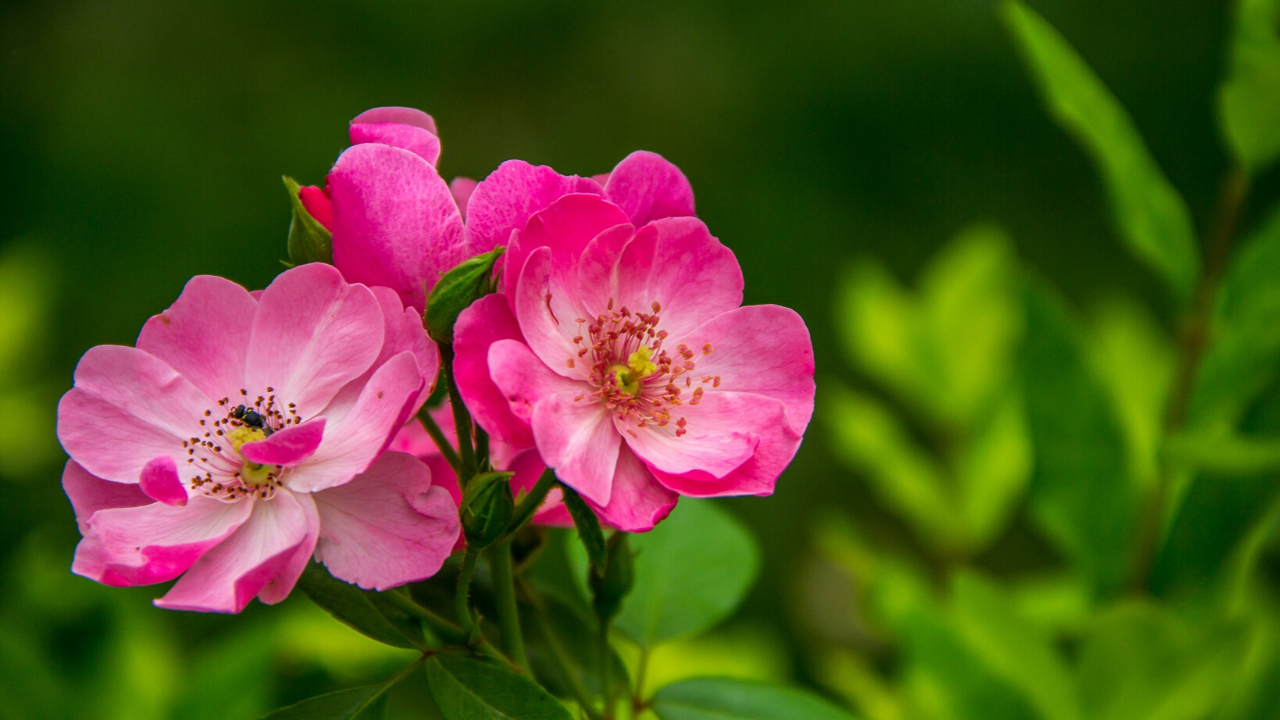
Summer has finally arrived. If you planted wildflowers this year, you might be asking yourself, “when will my wildflowers bloom?”
Unfortunately, when you’re growing a mixture of wildflower species, the answer isn’t always clearcut. Since most wildflower seed mixtures contain a vast array of species, they won’t all bloom at the same time. In fact, most mixes are carefully chosen so that you will get a wide overall bloom time rather than one explosive bloom.
There are lots of factors that influence when your wildflowers will bloom. Here’s what you need to know.
Traditional Flowering Times for Common Wildflower Species
The biggest factor in determining when your wildflowers will bloom is the species. Some bloom as early as April or May, including:

- Bluets
- Coltsfoot
- Trout lilies
- Butterweed
- Golden ragwort
- Violets
- Bluebells
- Trillium
- Phlox
- Oxeye daisy
- Buttercups
- Dame’s rocket
- Wild geranium
Others bloom in June and July:

- Butterfly milkweed
- Black-eyed Susan
- Coneflower
- Spiked lobelia
- White wild indigo
- John’s wort
- Wild bergamot
- Prairie clover
- Tall cinquefoil
There are still more that bloom late in the summer and into the fall, such as:

- Goldenrod
- Rough blazing star
- Round-headed bush clover
- Great lobelia
- Ironweed
- Prairie blazing star
- Evening primrose
- Cardinal flower
- Prairie dock
- Flowering spurge
- Tall coneflower
Consider the Season Rather Than the Month
As you likely already know, wildflowers don’t bloom based on a clock. They aren’t beholden to calendars and don’t have to look at their watch to know when it’s time to bloom or not! They bloom according to the weather.
Therefore, your flowers will bloom based on the length of day, how strong the sunlight is, and what the temperature of the air and soil are. Therefore, the arrival of flowers can vary depending on the year’s climatic conditions - as well as the season.
Forcing Early Wildflower Bloom
Does it seem like the wildflowers you find in bloom at your local garden center always seem to push out flowers sooner than the ones you grow in your backyard? That’s because they’ve been forced to bloom early - usually, by being grown in a greenhouse. They all germinated at approximately the same time.
Therefore, it is not usually possible to force an early wildflower bloom. Unless you’re growing in a greenhouse (which would defeat the purpose of growing wildflowers instead of regular, cultivated flowers) you are going to have a tough time manipulating the conditions in your wildflower patch.
Pay Attention to the Growing Conditions
The growing conditions in your area will heavily influence how soon your wildflowers bloom. For example, if you are experiencing extremely hot, dry weather, your bloom may be a bit slower to arrive than if the weather was moderately warm and wet. Too wet conditions, however, can also affect the vigor of a bloom, since some seeds may rot in the ground before they get the chance to sprout.
You can improve the likelihood of enjoying a beautiful bloom by planting in soil that has been amended with fertile compost and worked well to improve its water retention and drainage.
When will my wildflowers first bloom?
If you planted a mixture that contains wild annuals, your wildflower bloom will begin as soon as six weeks after the seed sprouts in the ground (usually no more than 12 weeks after planting). Therefore, if you planted in early May, your bloom should start in early June or July.
Which wildflowers will I see first?
The answer to this question depends on what you planted, but usually, you’ll see smaller wildflowers like baby blue eyes and baby’s breath first. These Bloom quickly and then die back or are eventually covered up by flowers with taller, later blooms.
When will my wildflower patch be in full bloom?
Assuming you added a few annuals to your wildflower mixture, you’ll usually have a full bloom - meaning all or most of your flowers have blossomed - in at least 90 days after they sprout.

Some of the first flowers you’ll see after baby’s breath include coneflowers, red poppies, and coreopsis. You may notice taller plants, too, like cosmos. These taller plants tend to hang on long into the fall and will bloom beautifully until the first frost.
Does planting perennial wildflowers affect the bloom?
Most wildflower mixtures come with a combination of annual and perennial seed, but that’s not always the case. If you only plant perennial wildflowers, you probably won’t see a bloom in your first year. These plants focus all of their energy in the first year on developing strong roots. Daisies, for example, only put on a few green leaves during the first year. The next year, and in subsequent years, you’ll get gorgeous flowers all season long.
Therefore, for instant color, you’ll want to plant a mixture with annuals - but for color that comes back every single year, be patient and grow a perennial mixture instead.
Is there a way to weed a wildflower patch?
One of the most difficult parts of growing a patch of wildflowers is telling the difference between wildflowers and weeds. It is incredibly challenging to weed a wildflower patch, which is why many gardeners simply let grass and weed grow alongside the cultivated wildflowers.
When your seedlings are small, the easiest way to tell if it’s a weed or a seedling is to look at the planting pattern. If it looks as though these seedlings are coming up in a relatively even pattern all over your wildflower patch, it’s probably a wildflower. If it’s sporadic, planted only here or there, it’s probably a weed.
As the season progresses, you might notice a few taller weeds or grasses growing alongside your wildflowers. If you can, avoid letting them go to seed. They should be pretty to identify as they get bigger and you can simply pull them out of the ground. Remove them when you see them so they don’t come back next year and multiply.
What is the best way to identify my seedlings?
Take a close look at your wildflower seed packet to figure out which species are in your mixture. This can vary, but often, you’ll be able to find more information and pictures for the chosen species online.

Some of the most common wildflower species include Gloriosa Daisy Rudbeckia, Helianthus annuus, and Chrysanthemum. A Gloriosa Daisy Rudbeckia will have fuzzy leaves and be much smaller in the first year, getting larger in subsequent years. Helianthus annuus produces large, sandpaper-like leaves, while Chrysanthemum has glossy green leaves that are small with serrated edges.
Can I collect and save wildflower seeds for next year?
If you want to expand your wildflower patch next year, a great way to do so is by collecting seed and moving it to a new meadow next year. Just watch the flowers carefully and gather the seed just as the flowers bloom.
To do this, wait until the flower fades and allow it to dry completely. You can then collect the small seed pod that’s left behind. Store it in a dry envelope until the following spring and you can replant.
How can I extend the bloom time of my wildflowers?
The best way to encourage a long bloom time for your flowers is to provide them with the optimal growing conditions. If it dries out for an extended period of time, your overall bloom will be reduced. Drought can quickly shut down a beautiful bloom.
You can also cut annual flowers to force more bloom. After all, the purpose of an annual flower is to create as much seed as possible in that first year. If you remove the flowers before they turn into seed pods, it will bud out and produce more flowers.
Should I cut my wildflowers to use in arrangements?
Yes. This is one of the best ways to keep your wildflower garden going, and it won’t ruin the look of your meadow like it might if you were cutting flowers from your cultivated flower beds.

Some wildflowers are better candidates for this than others. Red poppies, sadly, aren’t great cut flowers, as they drop their petals within less than 24 hours after being cut. Some of the best flowers to cut are black-eyed Susans, coneflowers, lupine, daisies, coreopsis, baby’s breath, and rose mallow.
Do I have to plant wildflower seeds in the spring?
You can plant wildflower seeds at most times of the year in most areas. Summer is a good time to plant, as this mimics the natural tendencies of the plants to drop seeds whenever they feel like it!
Just keep in mind that hot, dry conditions aren’t great for cultivating seed, and your seeds may not be as likely to thrive as they would if you planted in the spring. You might have to water often. If you plant in the fall, just keep in mind you probably won’t get much of a bloom before the first frost, but you will likely have early germination come spring.
What can I do to prepare for next year?
Pay close attention to other peoples’ wildflower meadows. What flowers do you like and would prefer to have included in your mixture? Take some notes and pictures. This will help you keep in mind the features and plants you would like to include for next year. Planning ahead is a good idea so you will have your seed ready to go come spring.




